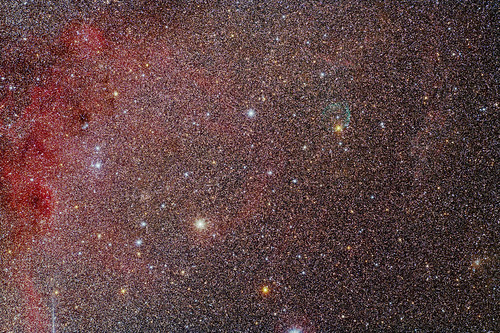Some Basic astronomy questions, if you will.
We look at this image, and can see a blue bubble, which is the result of processing some data that "is dominated by the glow of ionized oxygen". Can someone help me better understand this? I'm thinking that ...
- There is a particular wavelength of light that comes from the event of an electron dropping from an excited state to its base orbital in an Oxygen atom. Perhaps this is the [O III] emission line at 500.7 nm.
- This image is thus taken by observing a very tight frequency band, mapping the points where it is seen to this light blue color in the image, and seeing that this forms a nice, approximately circular shape on the field of view. (Simple geometry at a distance that we think we already know, gives it a diameter of 60 Lyr.)
- Using this shape -- and I can see that it also has subtlety of "shading", which is either an intensity difference, or a density-of-blue-pixels difference -- our built-in visual cortex processing and associated higher reasoning decides that this is probably a sphere in 3-D (... with a bit of a dolphin-nose irregularity at the upper left).
So we conclude that there is a spherical boundary of Oxygen here.
Some of the myriad of questions I need to answer or learn to set aside, if I am going to "get off of the ground floor of astronomy", are:
Do images like this just lead us neophytes by the hand ?
- I assume it is reasonable to conclude that the majority of Oxygen in the region photographed has this distribution ... it is mainly a spherical surface. There is, by comparison, almost no Oxygen in the interior of the surface (way less, anyway). There is not much Oxygen outside the surface. This is less clear to me, because a ways outside the surface, one is farther from the energizing star, so it could perhaps be out there, just not getting excited.
- There could be lots of other elements having similar, or even quite different shapes of distribution in this region. We are just selectively looking at the Oxygen. Is there any statement along with an image like this, to the effect of: "We looked at lots of other wavelengths and did not see much of interest." (?) Or should I still be wondering about the distribution of Hydrogen, Carbon, Magnesium, ... Silicon, Iron, etc. in this region? Perhaps with more images at wavelengths appropriate to other elements we would find that there is a bubble of Nitrogen that is different, but interesting in comparison to the Oxygen bubble. (Maybe this is one concern that I should just "set aside".)
The caption hinted that this Oxygen bubble exists, because the Oxygen that was emitted by the star, has met some resistance, so it is building up in a wave front as it expands away from the star.
- Does this imply there is a significant amount of some other material involved here? Do we know what that material would be? Does it have a characteristic signature by which we can detect its presence? Is it common outside of the bubble, but less so inside it, as the Oxygen has swept it outward? Do we know anything about its composition or density, or do we care?
- Does this spherical bubble shape point back to a single event of an Oxygen blast, or is it likely just a steady emission (wind), and the build-up is because of the resistance only? So is more Oxygen being emitted by the star today, just as it has been for a long time, or is it indicative of a single short-lived event (which for stars could mean quite a range of time intervals ... an "explosion" can probably take years in some cases, a "burst of Oxygen release" could perhaps be 100 years, in this image).
I mean, it is too easy for an amateur to look at an image and caption like this and say:
"Oh, this star suddenly blew out a bunch of Oxygen (and nothing else) on a violent day 70,000 years ago (maybe plus light travel time to Earth)."
I assume even professionals grapple
some with questions like the above, but I have the feeling that if I better understood more precisely what statements are being made and what are just my mistaken assumptions about the process, the findings, the careful thinking behind various conclusions, etc. then I would be better able to learn what I really can from an image such as this.
Thanks for reading, and thanks for any replies.
 Sharpless 308: Star Bubble
Sharpless 308: Star Bubble